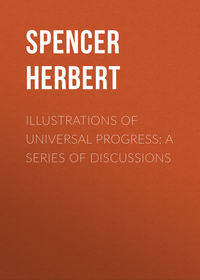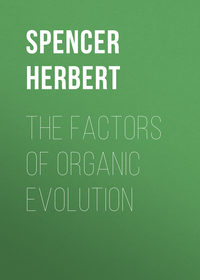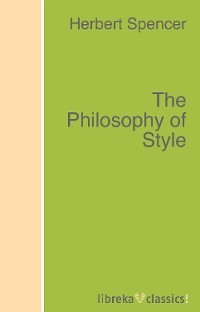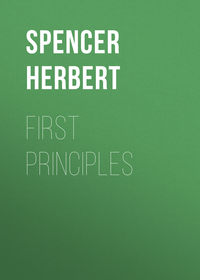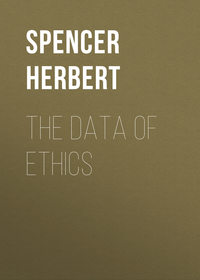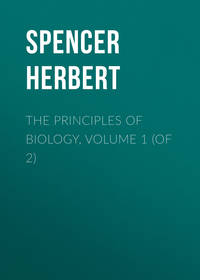 полная версия
полная версияEssays: Scientific, Political, and Speculative, Volume II
Without further argument it will, we think, be admitted that the sciences are none of them separately evolved – are none of them independent either logically or historically; but that all of them have, in a greater or less degree, required aid and reciprocated it. Indeed, it needs but to throw aside hypotheses, and contemplate the mixed character of surrounding phenomena, to see at once that these notions of division and succession in the kinds of knowledge are simply scientific fictions: good, if regarded merely as aids to study; bad, if regarded as representing realities in Nature. No facts whatever are presented to our senses uncombined with other facts – no facts whatever but are in some degree disguised by accompanying facts: disguised in such a manner that all must be partially understood before any one can be understood. If it be said, as by M. Comte, that gravitating force should be treated of before other forces, seeing that all things are subject to it, it may on like grounds be said that heat should be first dealt with; seeing that thermal forces are everywhere in action. Nay more, it may be urged that the ability of any portion of matter to manifest visible gravitative phenomena depends on its state of aggregation, which is determined by heat; that only by the aid of thermology can we explain those apparent exceptions to the gravitating tendency which are presented by steam and smoke, and so establish its universality; and that, indeed, the very existence of the Solar System in a solid form is just as much a question of heat as it is one of gravitation. Take other cases: – All phenomena recognized by the eyes, through which only are the data of exact science ascertainable, are complicated with optical phenomena, and cannot be exhaustively known until optical principles are known. The burning of a candle cannot be explained without involving chemistry, mechanics, thermology. Every wind that blows is determined by influences partly solar, partly lunar, partly hygrometric; and implies considerations of fluid equilibrium and physical geography. The direction, dip, and variations of the magnetic needle, are facts half terrestrial, half celestial – are caused by earthly forces which have cycles of change corresponding with astronomical periods. The flowing of the gulf-stream and the annual migration of icebergs towards the equator, involve in their explanation the Earth’s rotation and spheroidal form, the laws of hydrostatics, the relative densities of cold and warm water, and the doctrines of evaporation. It is no doubt true, as M. Comte says, that “our position in the Solar System, and the motions, form, size, and equilibrium of the mass of our world among the planets, must be known before we can understand the phenomena going on at its surface.” But, fatally for his hypothesis, it is also true that we must understand a great part of the phenomena going on at its surface before we can know its position, &c., in the Solar System. It is not simply that, as already shown, those geometrical and mechanical principles by which celestial appearances are explained, were first generalized from terrestrial experiences; but it is that even the obtainment of correct data on which to base astronomical generalizations, implies advanced terrestrial physics. Until after optics had made considerable advance, the Copernican system remained but a speculation. A single modern observation on a star has to undergo a careful analysis by the combined aid of various sciences – has to be digested by the organism of the sciences; which have severally to assimilate their respective parts of the observation, before the essential fact it contains is available for the further development of astronomy. It has to be corrected not only for nutation of the Earth’s axis and for precession of the equinoxes, but for aberration and for refraction; and the formation of the tables by which refraction is calculated, presupposes knowledge of the law of decreasing density in the upper atmospheric strata, of the law of decreasing temperature and the influence of this on the density, and of hygrometric laws as also affecting density. So that, to get materials for further advance, astronomy requires not only the indirect aid of the sciences which have presided over the making of its improved instruments, but the direct aid of an advanced optics, of barology, of thermology, of hygrometry; and if we remember that these delicate observations are in some cases registered electrically, and that they are further corrected for the “personal equation” – the time elapsing between seeing and registering, which differs with different observers – we may even add electricity and psychology. And here, before leaving these illustrations, and especially this last one, let us not omit to notice how well they exhibit that increasingly active consensus of the sciences which characterizes their advancing development. Besides finding that in these later times a discovery in one science commonly causes progress in others; besides finding that a great part of the questions with which modern science deals are so mixed as to require the co-operation of many sciences for their solution; we find that, to make a single good observation in the purest of the natural sciences, requires the combined aid of half a dozen other sciences.
Perhaps the clearest comprehension of the interconnected growth of the sciences may be obtained by contemplating that of the arts, to which it is strictly analogous, and with which it is bound up. Most intelligent persons must have been occasionally struck with the numerous antecedents pre-supposed by one of our processes of manufacture. Let him trace the production of a printed cotton, and consider all that is implied by it. There are the many successive improvements through which the power-looms reached their present perfection; there is the steam-engine that drives them, having its long history from Papin downwards; there are the lathes in which its cylinder was bored, and the string of ancestral lathes from which those lathes proceeded; there is the steam-hammer under which its crank shaft was welded; there are the puddling furnaces, the blast-furnaces, the coal-mines and the iron-mines needful for producing the raw material; there are the slowly improved appliances by which the factory was built, and lighted, and ventilated; there are the printing engine, and the dye-house, and the colour-laboratory with its stock of materials from all parts of the world, implying cochineal-culture, logwood-cutting, indigo-growing; there are the implements used by the producers of cotton, the gins by which it is cleaned, the elaborate machines by which it is spun; there are the vessels in which cotton is imported, with the building-slips, the rope-yards, the sail-cloth factories, the anchor-forges, needful for making them; and besides all these directly necessary antecedents, each of them involving many others, there are the institutions which have developed the requisite intelligence, the printing and publishing arrangements which have spread the necessary information, the social organization which has rendered possible such a complex co-operation of agencies. Further analysis would show that the many arts thus concerned in the economical production of a child’s frock, have each been brought to its present efficiency by slow steps which the other arts have aided; and that from the beginning this reciprocity has been on the increase. It needs but on the one hand to consider how impossible it is for the savage, even with ore and coal ready, to produce so simple a thing as an iron hatchet; and then to consider, on the other hand, that it would have been impracticable among ourselves, even a century ago, to raise the tubes of the Britannia bridge from lack of the hydraulic press; to see how mutually dependent are the arts, and how all must advance that each may advance. Well, the sciences are involved with each other in just the same manner. They are, in fact, inextricably woven into this same complex web of the arts; and are only conventionally independent of it. Originally the two were one. How to fix the religious festivals; when to sow; how to weigh commodities; and in what manner to measure ground; were the purely practical questions out of which arose astronomy, mechanics, geometry. Since then there has been a perpetual inosculation of the sciences and the arts. Science has been supplying art with truer generalizations and more completely quantitative previsions. Art has been supplying science with better materials, and more perfect instruments. And all along the interdependence has been growing closer, not only between art and science, but among the arts themselves, and among the sciences themselves. How completely the analogy holds throughout, becomes yet clearer when we recognize the fact that the sciences are arts to one another. If, as occurs in almost every case, the fact to be analyzed by any science, has first to be prepared – to be disentangled from disturbing facts by the afore discovered methods of other sciences; the other sciences so used, stand in the position of arts. If, in solving a dynamical problem, a parallelogram is drawn, of which the sides and diagonal represent forces, and by putting magnitudes of extension for magnitudes of force a measurable relation is established between quantities not else to be dealt with; it may be fairly said that geometry plays towards mechanics much the same part that the fire of the founder plays towards the metal he is going to cast. If, in analyzing the phenomena of the coloured rings surrounding the point of contact between two lenses, a Newton ascertains by calculation the amount of certain interposed spaces, far too minute for actual measurement; he employs the science of number for essentially the same purpose as that for which the watchmaker employs tools. If, before calculating the orbit of a comet from its observed position, the astronomer has to separate all the errors of observation, it is manifest that the refraction-tables, and logarithm-books, and formulæ, which he successively uses, serve him much as retorts, and filters, and cupels serve the assayer who wishes to separate the pure gold from all accompanying ingredients. So close, indeed, is the relationship, that it is impossible to say where science begins and art ends. All the instruments of the natural philosopher are the products of art; the adjusting one of them for use is an art; there is art in making an observation with one of them; it requires art properly to treat the facts ascertained; nay, even the employing established generalizations to open the way to new generalizations, may be considered as art. In each of these cases previously organized knowledge becomes the implement by which new knowledge is got at: and whether that previously organized knowledge is embodied in a tangible apparatus or in a formula, matters not in so far as its essential relation to the new knowledge is concerned. If art is applied knowledge, then such portion of a scientific investigation as consists of applied knowledge is art. Hence we may even say that as soon as any prevision in science passes out of its originally passive state, and is employed for reaching other previsions, it passes from theory into practice – becomes science in action – becomes art. And after contemplating these facts, we shall the more clearly perceive that as the connexion of the arts with each other has been becoming more intimate; as the help given by sciences to arts and by arts to sciences, has been age by age increasing; so the interdependence of the sciences themselves has been ever growing greater, their relations more involved, their consensus more active.
In here ending our sketch of the Genesis of Science, we are conscious of having done the subject but scant justice. Two difficulties have stood in our way: one, the having to touch on so many points in such small space; the other, the necessity of treating in serial arrangement a process which is not serial. Nevertheless, we believe the evidence assigned suffices to substantiate the leading propositions with which we set out. Inquiry into the first stages of science confirms the conclusion drawn from analysis of science as now existing, that it is not distinct from common knowledge, but an outgrowth from it – an extension of perception by means of reason. That more specific characteristic of scientific previsions, which was analytically shown to distinguish them from the previsions of uncultured intelligence – their quantitativeness – we also see to have been the characteristic alike of the initial steps in science, and of all the steps succeeding them. The facts and admissions cited in disproof of the assertion that the sciences follow one another, both logically and historically, in the order of their decreasing generality, have been enforced by the instances we have met with, showing that a more general science as much owes its progress to the presentation of new problems by a more special science, as the more special science owes its progress to the solutions which the more general science is thus led to attempt – instances, therefore, illustrating the position that scientific advance is as much from the special to the general as from the general to the special. Quite in harmony with this position we find to be the admissions that the sciences are as branches of one trunk, and that they were at first cultivated simultaneously. This harmony becomes the more marked on finding, as we have done, not only that the sciences have a common root, but that science in general has a common root with language, classification, reasoning, art; that throughout civilization these have advanced together, acting and reacting upon each other just as the separate sciences have done; and that thus the development of intelligence in all its divisions and sub-divisions has conformed to this same law which we have shown that the sciences conform to. From all which we may perceive that the sciences can with no greater propriety be arranged in a succession, than language, classification, reasoning, art, and science, can be arranged in a succession; that, however needful a succession may be for the convenience of books and catalogues, it must be recognized as merely a convention; and that so far from its being the function of a philosophy of the sciences to establish a hierarchy, it is its function to show that the linear arrangements required for literary purposes, have none of them any basis either in Nature or History.
There is one further remark we must not omit – a remark touching the importance of the question that has been discussed. Topics of this abstract nature are commonly slighted as of no practical moment; and, doubtless, many will think it of little consequence what theory respecting the genesis of science may be entertained. But the value of truths is often great, in proportion as their generality is wide. And it must be so here. A correct theory of the development of the sciences must have an important effect on education; and, through education, on civilization. Much as we differ from him in other respects, we agree with M. Comte in the belief that, rightly conducted, the education of the individual must have a certain correspondence with the evolution of the race. No one can contemplate the facts we have cited in illustration of the early stages of science, without recognizing the necessity of the processes through which those stages were reached – a necessity which, in respect to the leading truths, may likewise be traced in all after stages. This necessity, originating in the very nature of the phenomena to be analyzed and the faculties to be employed, partially applies to the mind of the child as to that of the savage. We say partially, because the correspondence is not special but general only. Were the environment the same in both cases, the correspondence would be complete. But though the surrounding material out of which science is to be organized, is, in many cases, the same to the juvenile mind and the aboriginal mind, it is not so throughout; as, for instance, in the case of chemistry, the phenomena of which are accessible to the one but were inaccessible to the other. Hence, in proportion as the environment differs, the course of evolution must differ. After admitting exceptions, however, there remains a substantial parallelism; and, if so, it is of moment to ascertain what really has been the process of scientific evolution. The establishment of an erroneous theory must be disastrous in its educational results; while the establishment of a true one must be fertile in school-reforms and consequent social benefits.
THE CLASSIFICATION OF THE SCIENCES
[ First published as a brochure in April 1864. The preface to the second edition, published in April 1869, I reproduce because of certain facts contained in it which are not without interest.]The first edition of this Essay is not yet out of print. But a proposal to translate it into French having been made by Professor Réthoré, I have decided to prepare a new edition free from the imperfections which criticism and further thought have disclosed, rather than allow these imperfections to be reproduced.
The occasion has almost tempted me into some amplification. Further arguments against the classification of M. Comte, and further arguments in support of the classification here set forth, have pleaded for utterance. But reconsideration has convinced me that it is both needless and useless to say more – needless because those who are not committed will think the case sufficiently strong as it stands; and useless because to those who are committed, additional reasons will seem as inadequate as the original ones. [In the preface to the third edition, however, a reason is given for a change of decision on this point at that time made (February 1871): the reason being “the publication of several objections by Prof. Bain in his Logic.”]
This last conclusion is thrust on me by seeing how little M. Littré, the leading expositor of M. Comte, is influenced by fundamental objections the force of which he admits. After quoting one of these, he says, with a candour equally rare and admirable, that he has vainly searched M. Comte’s works and his own mind for an answer. Nevertheless, he adds – “j’ai réussi, je crois, à écarter l’attaque de M. Herbert Spencer, et à sauver le fond par des sacrifices indispensables mais accessoires.” The sacrifices are these. He abandons M. Comte’s division of Inorganic Science into Celestial Physics and Terrestrial Physics – a division which, in M. Comte’s scheme, takes precedence of all the rest; and he admits that neither logically nor historically does Astronomy come before Physics, as M. Comte alleges. After making these sacrifices, which most will think too lightly described as “sacrifices indispensables mais accessoires,” M. Littré proceeds to rehabilitate the Comtean classification in a way which he considers satisfactory, but which I do not understand. In short, the proof of these incongruities affects his faith in the Positivist theory of the sciences, no more than the faith of a Christian is affected by proof that the Gospels contradict one another.
Here in England I have seen no attempt to meet the criticisms with which M. Littré thus deals. There has been no reply to the allegation, based on examples, that the several sciences do not develop in the order of their decreasing generality; nor to the allegation, based on M. Comte’s own admissions, that within each science the progress is not, as he says it is, from the general to the special; nor to the allegation that the seeming historical precedence of Astronomy over Physics in M. Comte’s pages, is based on a verbal ambiguity – a mere sleight of words; nor to the allegation, abundantly illustrated, that a progression in an order the reverse of that asserted by M. Comte may be as well substantiated; nor to various minor allegations equally irreconcileable with his scheme. I have met with nothing more than iteration of the statement that the sciences do conform, logically and historically, to the order in which M. Comte places them; regardless of the assigned evidence that they do not.
Under these circumstances it is unnecessary for me to say more; and I think I am warranted in continuing to hold that the Comtean classification of the sciences is demonstrably untenable.
In an essay on “The Genesis of Science,” originally published in 1854, I endeavoured to show that the Sciences cannot be rationally arranged in serial order. Proof was given that neither the succession in which the Sciences are placed by M. Comte (to a criticism of whose scheme the essay was in part devoted), nor any other succession in which the Sciences can be placed, represents either their logical dependence or their historical dependence. To the question – How may their relations be rightly expressed? I did not then attempt any answer. This question I propose now to consider.
A true classification includes in each class, those objects which have more characteristics in common with one another, than any of them have in common with any objects excluded from the class. Further, the characteristics possessed in common by the colligated objects, and not possessed by other objects, involve more numerous dependent characteristics. These are two sides of the same definition. For things possessing the greatest number of attributes in common, are things that possess in common those essential attributes on which the rest depend; and, conversely, the possession in common of the essential attributes, implies the possession in common of the greatest number of attributes. Hence, either test may be used as convenience dictates.
If, then, the Sciences admit of classification at all, it must be by grouping together the like and separating the unlike, as thus defined. Let us proceed to do this.
The broadest natural division among the Sciences, is the division between those which deal with the abstract relations under which phenomena are presented to us, and those which deal with the phenomena themselves. Relations of whatever orders, are nearer akin to one another than they are to any objects. Objects of whatever orders, are nearer akin to one another than they are to any relations. Whether, as some hold, Space and Time are nothing but forms of Thought 2; or whether, as I hold myself, they are forms of Things, that have generated forms of Thought through organized and inherited experience of Things; it is equally true that Space and Time are contrasted absolutely with the existences disclosed to us in Space and Time; and hence the Sciences which deal exclusively with Space and Time, are separated by the profoundest of all distinctions from the Sciences which deal with the existences contained in Space and Time. Space is the abstract of all relations of co-existence. Time is the abstract of all relations of sequence. And dealing as they do entirely with relations of co-existence and sequence, in their general or special forms, Logic and Mathematics form a class of the Sciences more widely unlike the rest, than any of the rest are from one another.
The Sciences which deal with existences themselves, instead of the blank forms in which existences are presented to us, admit of a sub-division less profound than the division above made, but more profound than any of the divisions among the Sciences individually considered. They fall into two classes, having quite different aspects, aims, and methods. Every phenomenon is more or less composite – is a manifestation of force under several distinct modes. Hence result two objects of inquiry. We may study the component modes of force separately; or we may study them as co-operating to generate in this composite phenomenon. On the one hand, neglecting all the incidents of particular cases, we may aim to educe the laws of each mode of force, when it is uninterfered with. On the other hand, the incidents of the particular case being given, we may seek to interpret the entire phenomenon, as a product of the several forces simultaneously in action. The truths reached through the first kind of inquiry, though concrete inasmuch as they have actual existences for their subject-matters, are abstract inasmuch as they refer to the modes of existence apart from one another; while the truths reached by the second kind of inquiry are properly concrete, inasmuch as they formulate the facts in their combined order, as they occur in Nature.
The Sciences, then, in their main divisions, stand thus: —
• SCIENCE is
• that which treats of the forms in which phenomona are known to us: ABSTRACT SCIENCE (Logic and Mathematics)


